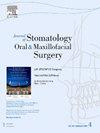Intraoral anastomosis technique as part of the reconstruction strategy following resection of intermediate and low-grade head and neck cancer
IF 1.8
3区 医学
Q2 DENTISTRY, ORAL SURGERY & MEDICINE
Journal of Stomatology Oral and Maxillofacial Surgery
Pub Date : 2025-02-13
DOI:10.1016/j.jormas.2025.102282
引用次数: 0
Abstract
Introduction
The gold standard for curative treatment of facial, oral, nasal, paranasal and pharyngeal cancers is excision and reconstruction surgery. Patients are increasingly demanding carcinologically effective and minimally invasive surgery with near ad integrum functional and aesthetic reconstruction. In malignant tumors with no indication for lymph node dissection, when the defect size dictates free flap reconstruction, the intrabuccal anastomosis technique comes closest to meeting these requirements.
Material and methods
In this single-center retrospective observational study, we reported a series of 5 patients with intermediate or low-grade head and neck cancer treated by surgery between 2022 and 2023 at the Cervico-facial Surgery Department of the Gustave Roussy Cancer Center. We collected clinical, therapeutic, histologic, and carcinologic data.
Results
All patients underwent tumor resection with fascio-cutaneous free flap reconstruction and dental rehabilitation in accordance with best practice recommendations. None of the patients had an indication for lymph node dissection. The histologic subtypes were glandular, epithelial, and cartilaginous-related. All anastomoses were performed on the facial vessels using an intraoral anastomosis technique.
Conclusion
Free flap with intraoral anastomosis technique may be the first intention reconstruction strategy for large defects following resection of intermediate and low-grade malignant tumors of the face and oral, oropharyngeal, nasal or paranasal cavities.
口内吻合技术作为中低级别头颈癌切除术后重建策略的一部分。
面部、口腔、鼻部、副鼻部和咽癌根治治疗的金标准是切除和重建手术。患者越来越多地要求肿瘤有效和微创手术与近整体功能和美学重建。在没有淋巴结清扫指征的恶性肿瘤中,当缺损大小决定了自由皮瓣重建时,颊内吻合技术最能满足这些要求。材料和方法:在这项单中心回顾性观察研究中,我们报道了在Gustave Roussy癌症中心颈面部外科于2022年至2023年期间接受手术治疗的5例中低级别头颈癌患者。我们收集了临床、治疗、组织学和癌变的资料。结果:所有患者均按照最佳实践建议行肿瘤切除、筋膜-皮肤游离皮瓣重建及牙齿康复。所有患者均无淋巴结清扫指征。组织学亚型为腺、上皮和软骨相关。面部血管吻合术均采用口内吻合技术。结论:游离皮瓣联合口内吻合技术可作为面部及口腔、口咽、鼻、副鼻腔等中低度恶性肿瘤切除术后大面积缺损的首选重建策略。
本文章由计算机程序翻译,如有差异,请以英文原文为准。
求助全文
约1分钟内获得全文
求助全文
来源期刊

Journal of Stomatology Oral and Maxillofacial Surgery
Surgery, Dentistry, Oral Surgery and Medicine, Otorhinolaryngology and Facial Plastic Surgery
CiteScore
2.30
自引率
9.10%
发文量
0
审稿时长
23 days
 求助内容:
求助内容: 应助结果提醒方式:
应助结果提醒方式:


